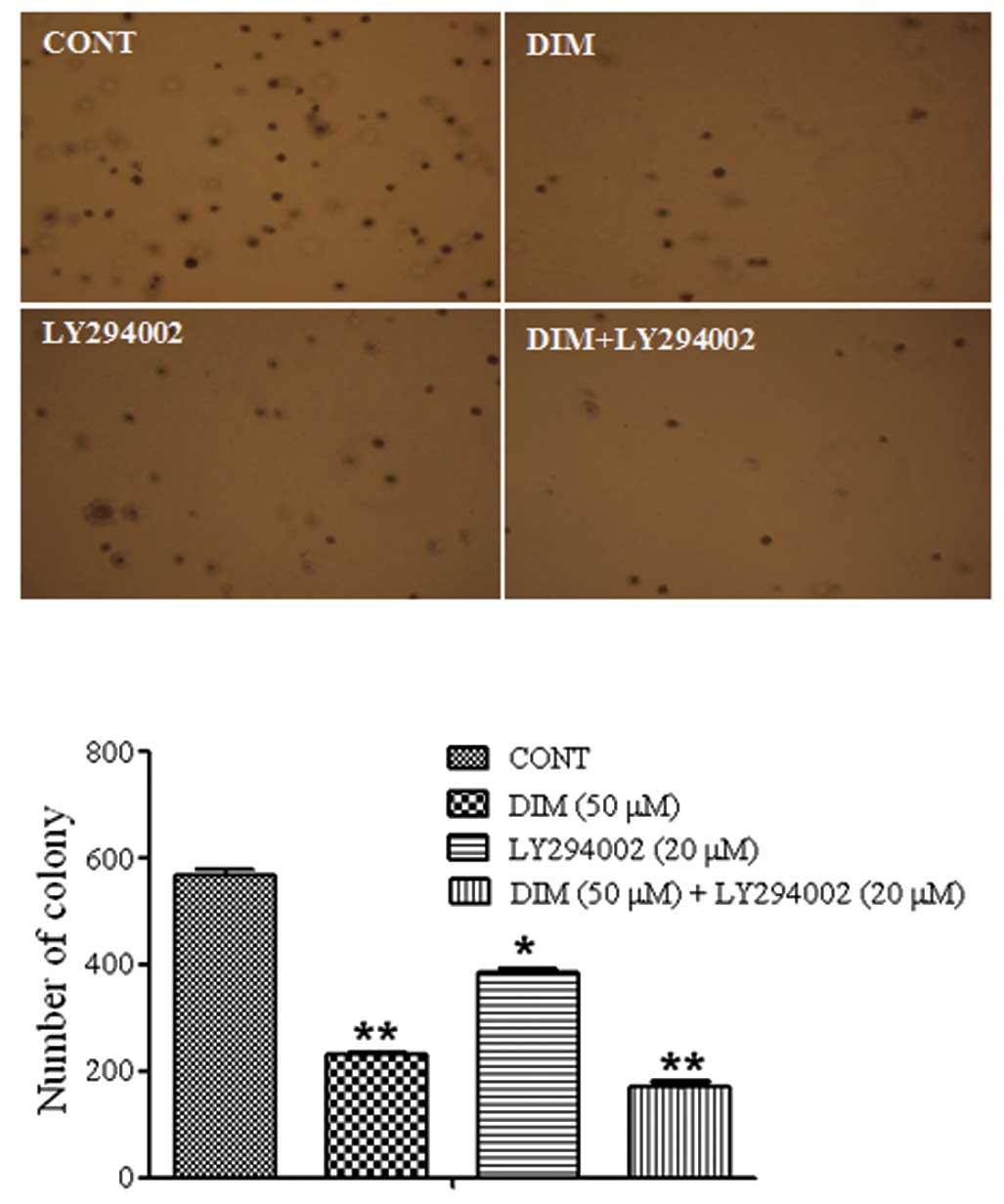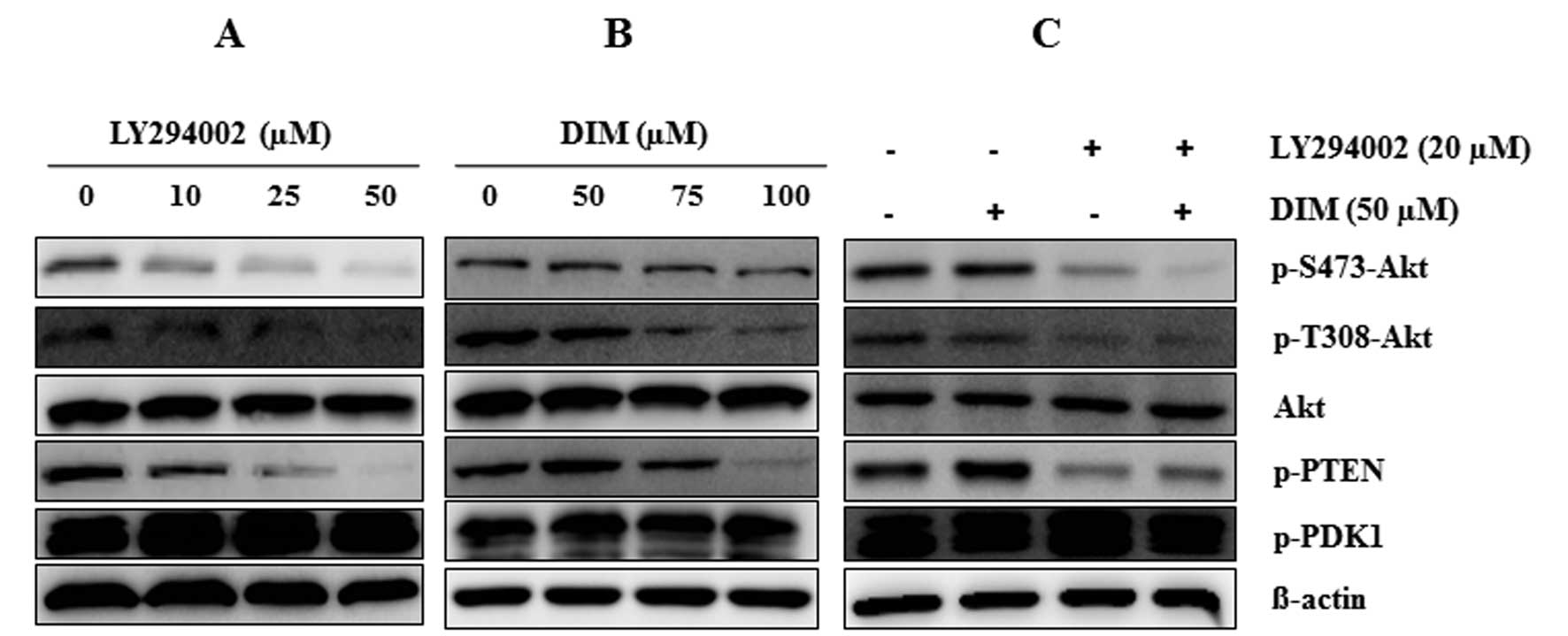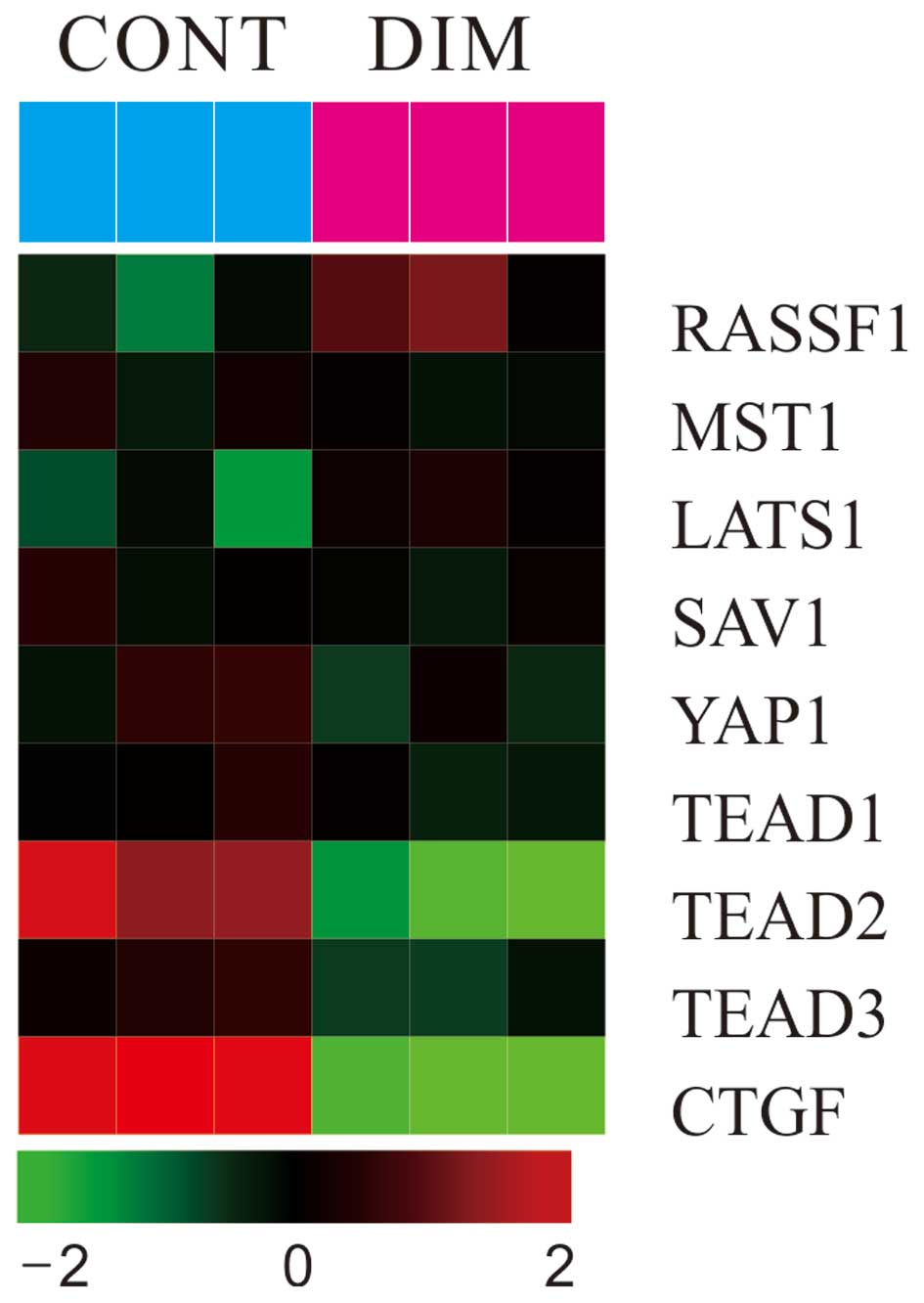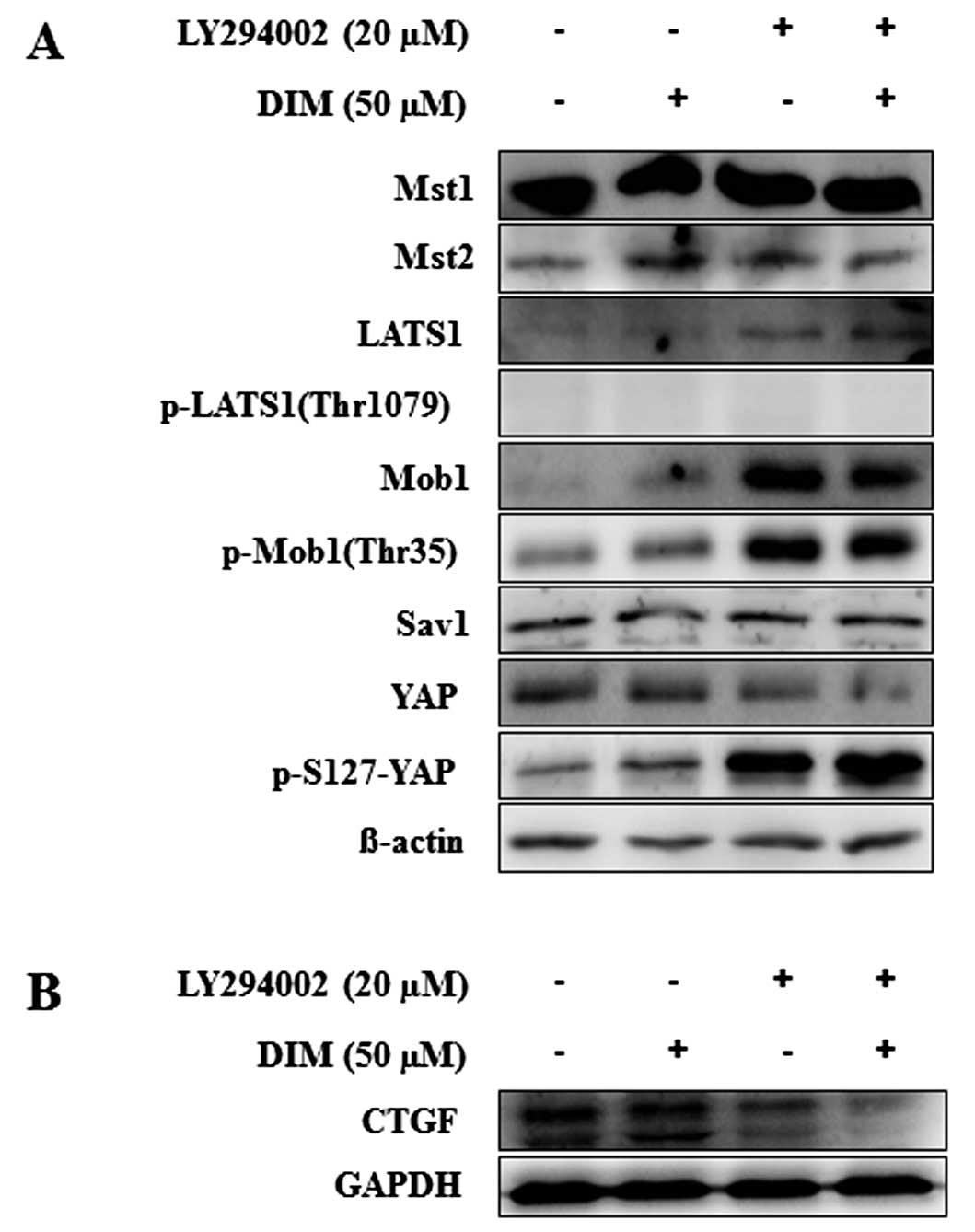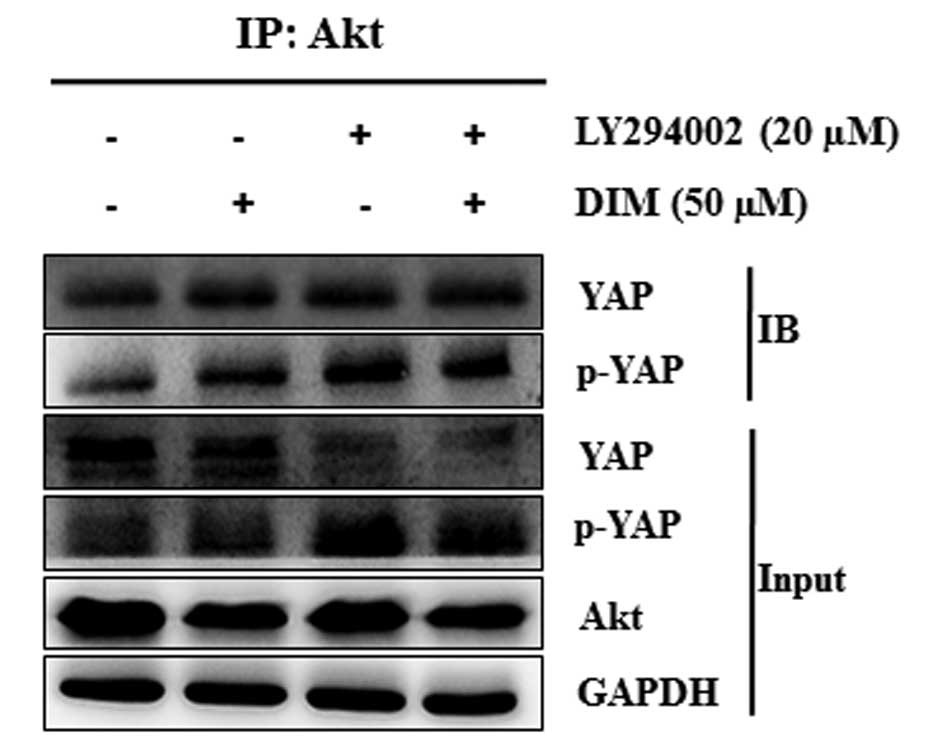Regulation of YAP through an Akt-dependent process by 3, 3'-diindolylmethane in human colon cancer cells
- Authors:
- Published online on: October 3, 2013 https://doi.org/10.3892/ijo.2013.2121
- Pages: 1992-1998
Abstract
Introduction
Colon cancer, the second most deadly malignancy in the USA and a serious public health problem worldwide, has seen a growing incidence in South Korea (1,2). Since the accumulation of a variety of genetic alterations drives colon cancer progression, much attention has been paid to the PI3K/Akt pathway, which is responsible for carcinogenesis and metastasis of colon cancer because it regulates the cell cycle, growth, proliferation and survival (3–7). Several studies have revealed that the PI3K/Akt pathway has an important role in the early stages of sporadic colorectal cancer and is activated and overexpressed in colon cancers (5,8,9). The PI3K/Akt pathway has also been demonstrated to be responsible for carcinogenesis of colon cancer (3,10). Given its prominent role in cancer development, inhibition of this pathway might be one of the most effective ways to conquer colon cancer. Selective inhibitors of different molecules in this pathway have been developed as molecular targeted anticancer therapies and a number of studies are currently being conducted to investigate the role of PI3K/Akt inhibitors in patients with advanced tumors (5,11–13). However, it has been found that a single agent is unable to disrupt the proliferation of the cancer cells due to its modest activity (5,13,14).
The Hippo signaling pathway was first identified in nematodes and is evolutionarily conserved with mammals. Although the mechanism by which Hippo signaling regulates cell growth has not been clearly understood, it appears to play a major role in controlling organ size and cell proliferation (15). Loss of Hippo signaling elicits cancer development due to unlimited cell proliferation and deregulation of the Hippo signaling pathway has been observed in various cancers, including colon cancer. The main core mediators of the Hippo pathway are Mst1/2, LATS1/2, Mob and Sav. When the Hippo pathway is active, Mst1/2, Lats1/2 and Mob form a complex that prevents the nuclear localization of YAP, a key effector protein of the Hippo pathway, by direct phosphorylation. On the other hand, when the Hippo pathway is inactive, YAP moves into the nucleus, which eventually leads to YAP accumulation in the nucleus and activation of transcription factors. Moreover, YAP expression has been observed in colon cancer (16–18) and it is overexpressed in human colon cancer specimens. Overexpression of YAP stimulates cell growth and survival in colon cancer cells (19,20).
DIM (3, 3′-diindolylmethane) is a natural compound derived from cruciferous vegetables such as broccoli, cabbage and cauliflower. Although several studies have shown that DIM has anti-proliferative effects in a variety of cancer cell types including human colon, pancreas, prostate and breast cancer (13–23), the cellular apoptotic mechanism of DIM on cancer cells has not been fully elucidated. We have recently studied the antitumor effect of DIM in gastric cancer in vivo and in vitro through activation of Hippo signaling (unpublished data). Since PI3K/Akt signaling is known to play a critical role in growth control, we wondered whether DIM has an effect on Hippo signaling, mediated via the PI3K/Akt signaling pathway in colon cancer cells. We demonstrate that DIM induces apoptosis in human colon cancer cells by activating the Hippo signaling pathway followed by inactivation of the PI3K/Akt signaling pathway. The present findings have important implications for the clinical use of DIM in colon cancer prevention.
Materials and methods
Cell culture
The human colon cancer cell line HCT116 was obtained from the University of Texas M.D. Anderson Cancer Center (Houston, TX, USA). HCT116 was cultured in DMEM-F12 medium (Gibco, Grand Island, NY, USA) supplemented with 10% fetal bovine serum (Gibco), 100 mg/ml streptomycin and 100 IU/ml penicillin as a monolayer in 100-mm dishes (BD Biosciences, Sparks, MD, USA) under standard conditions at 37°C in a 5% CO2 humidified atmosphere.
Reagent
DIM was purchased from LKT Laboratories (St. Paul, MN, USA). Antibodies to cleaved-caspase-9, caspase-3, cleaved poly(ADP-ribose) polymerase (PARP), p-PTEN, Akt, p-S473-Akt, p-T308-Akt, p-GSK-3β, p-PDK1, YAP and p-YAP were purchased from Cell Signaling Technology (Beverly, MA, USA).
MTT assay
Cell viability of DIM, LY294002 and DIM plus LY294002 on HCT116 cells was determined by MTT assay (3-[4,5-dimethylthiazol-2-yl]-2,5-diphenyltetrazolium bromide) as described previously (21,22). In brief, HCT116 cells were seeded with 1×104 cells per well into 96-well plates (SPL, Seoul, Korea). After 24 h of cell seeding, HCT116 cells were treated with DIM, LY294002 and DIM plus LY294002 in a dose-dependent manner for 1, 2 and 3 days. The cells were then incubated with 50 μl of MTT (2 mg/ml in PBS) for 3 h at 37°C and 200 μl of DMSO (Sigma) was added to solubilize the crystals for 30 min at room temperature. Cell viability was determined by a scanning multiwall spectrophotometer (SpectraMAX 340, Molecular Devices Co., Sunnyvale, CA, USA).
Soft agar colony formation assay
Survival of colon carcinoma cells was tested by soft agar colony formation assay, as described before. Briefly, cells were exposed to DIM (50 μM), LY294002 (20 μM) and DIM (50 μM) plus LY29402 (20 μM) in 6-well plates and were cultured in an incubator at 37°C with 5% CO2 for 2 weeks. Colony formation was observed by microscopy and the counted and quantitated.
Western blotting
Cells with or without DIM or LY294002 were harvested and suspended in lysis buffer (Intron Biotechnology, Korea). Cell extracts were incubated on ice for 20 min and centrifuged at 13,000 × g for 5 min at 4°C. The protein concentration was determined using a BSA Protein Assay kit (Pierce, Rockford, IL, USA). Whole lysate was resolved on an SDS-PAGE gel, transferred to a PVDF membrane (Bio-Rad, Hercules, CA, USA) by electroblotting and then probed with mouse anti-human cyclin D1, rabbit anti-human CDK2, mouse anti-human CDK4, mouse anti-human CDK6, rabbit anti-human p27, rabbit anti-human p15, rabbit anti-human cleaved-caspase-9, rabbit anti-human cleaved PARP, rabbit anti-human Akt, rabbit anti-human p-S473-Akt, rabbit anti-human p-T308-Akt, rabbit anti-human p-PTEN, rabbit anti-human p-GSK3β, rabbit anti-human p-PDK1, rabbit anti-human p-YAP and YAP antibodies (Cell Signaling Technology). The membrane was then washed with TBS-T (10X TBS and 0.1% Tween-20) and incubated for an additional 1 h with HRP-linked anti-rabbit and anti-mouse antibodies (Cell Signaling Technology). Protein bands were visualized with the Enhanced Chemiluminescence kit (Amersham, Arlington Heights, IL, USA).
Microarray
Total RNA was isolated from the cells by using a mirVana™ miRNA isolation labeling kit (Ambion Inc., TX, USA) according to the manufacturer’s protocol. Biotin-labeled cRNA was prepared using an Illumina Total Prep RNA amplification kit (Ambion Inc.) for hybridization. Samples were hybridized in Illumina Human-12 BeadChip V.4 microarray (Illumina, CA, USA). Gene expression data were extracted from the Genome Studio (Illumina). Data were normalized using the quantile normalization method in the Linear Models for Microarray data package in the program R. A heat map of gene expression was generated using the Cluster and Treeview programs (23). A microarray study was performed by the Shared Research Equipment Assistance Program by Korea Basic Science Institute, MEST.
Statistical analysis
The experimental results are shown as mean ± SE. Student’s t-test and one-way ANOVA were used to test for significant differences among the experimental groups. P-values <0.05 were considered significant.
Results
Cell growth inhibition by LY294002 and DIM treatment
We tested several doses of DIM and LY294002 at 72 h in HCT116 cells. As shown in Fig. 1, LY294002 inhibited cell viability in a dose-dependent manner. The IC50 of LY294002 was ∼20–25 μM. DIM also inhibited HCT116 cells in a dose-dependent manner. The IC50 concentration of LY294002 (20 μM) with a modestly toxic concentration of DIM (50 and 75 μM, 20–40% apoptosis at 72 h) resulted in a significant growth inhibition (60–80% at 72 h) of HCT116 cells compared with either agent alone, suggesting a significant inhibitory effect of combination treatment in colon carcinoma cells. These results indicate that the combination of LY294002 with a lower dose of DIM evoked significantly greater inhibition of colon cancer cell growth compared with either agent alone.
Inhibitory effect of LY294002 and DIM on clonogenicity
The effect of LY294002 and DIM treatment in vitro on HCT116 cell colony formation was evaluated by the soft agar cloning assay. Treatment with LY294002 (20 μM) and DIM (50 μM) resulted in a significant inhibition of colony formation in HCT116 cells when compared with single agent treatment (Fig. 2).
Induction of apoptosis by LY294002 and DIM treatment
The cell viability was further evaluated by determining the apoptotic effects. Sub-G1 population was significantly increased by the combination treatment of LY294002 (20 μM) and DIM (50 μM) compared with either agent alone (Fig. 3A). We found that the combination of DIM and LY294002 resulted in a significant induction of apoptosis in colon cancer cells. We further examined cleaved-caspase-9, cleaved-PARP and pro-caspase-3 protein levels in the HCT116 colon cancer cell line. As shown in Fig. 3B, the combination with LY294002 (20 μM) and DIM (50 μM) significantly increased the cleaved-caspase-9 and cleaved-PARP protein levels compared with the cells treated with LY294002 or DIM alone. Pro-caspase-3 protein levels were also significantly decreased by the combination treatment. These data indicate that the combination of DIM and LY294002 induces more dramatic apoptotic cell death in the human colon cancer cell line HCT116 than single agent treatment.
Downregulation of the Akt pathway by DIM
To investigate the effect of DIM on the PI3K/Akt pathway, we detected the expression of PI3K/Akt pathway proteins. As shown in Fig. 4, LY294002 significantly suppressed the expression of Akt pathway proteins (p-S473-Akt, p-T308-Akt, p-PTEN and p-GSK) in a dose-dependent manner (0, 10, 25 and 50 μM). DIM also significantly inhibited the expression of Akt pathway proteins as effectively as the PI3K inhibitor. The combination treatment of LY294002 with DIM notably suppressed the expression of p-S473-Akt, p-T308-Akt and p-PTEN, although the expressions of Akt and p-PDK1 protein levels were not altered by the combination treatment of DIM and LY294002 or alone. Thus, our findings suggest that the combination of LY294002 and DIM significantly induced the inactivation of the PI3K/Akt pathway more than the single treatment alone.
Gene expression levels of the Hippo signaling pathway by DIM treatment
To investigate the effect of DIM on gene expression levels in colon carcinoma cells, microarray was performed. As shown in Fig. 5, the administration of DIM (100 μM) significantly induced the expression of RASSF1 gene and mildly increased the Mst1, LATS1 gene expression levels. DIM also significantly decreased the expression of the YAP1 gene together with downstream target genes (TEAD1/2/3 and CTGF) of YAP in colon cancer cells.
DIM activates Hippo signaling and suppresses the YAP activity
To further investigate the effect of LY294002 and DIM on the Hippo signaling pathway, we examined the protein levels of Mst1/2, LATS1, p-LATS1, Mob1, p-Mob1, Sav1, YAP and p-YAP after LY294002 (20 μM) and DIM (50 μM) treatment at 72 h. As shown in Fig. 6A, the expression of LATS1, Mob1 and p-Mob1 proteins was significantly increased in HCT116 cells by the treatment of LY294002 and DIM. We found that the production of p-YAP protein expression was increased and YAP protein levels were decreased by the treatment of LY294002 and DIM in HCT116 cells. The combination of LY294002 and DIM significantly increased the expression of p-YAP protein, an inactive form of YAP, compared to single treatment alone. The downstream target gene of YAP, the CTGF protein, was also significantly decreased by the combination treatment of LY294002 and DIM (Fig. 6B). These results suggest that the combination treatment of LY294002 with DIM significantly enhanced the activation of the Hippo signaling pathway, which inhibits colon cancer cell growth and proliferation.
DIM enhances the binding capacity between Akt and YAP in colon cancer cells
IP was performed to detect the interaction between Akt and YAP. As shown in Fig. 7, we found that the Akt-YAP binding complex significantly increased after treatment with LY294002 and DIM. The combination treatment of LY294002 with DIM significantly increased the binding ability of Akt and YAP proteins. The ability of p-YAP to bind with Akt was also increased by the combination treatment of LY294002 with DIM. The increased binding ability between Akt and YAP due to the combination treatment of LY294002 and DIM may prevent the nuclear localization of YAP and induce the proapoptotic gene expression. Our results showed that the inactivation of Akt together with the induced phosphorylation of YAP, due to the treatment of LY294002 with DIM, subjected the cells to apoptosis.
Discussion
Cancer development is a complex process governed by the interaction of several signaling pathways that regulate normal cell growth and proliferation. The Hippo and PI3K/Akt pathways have been shown to play a critical role in monitoring tissue growth involved in the regulation of organ size all the way through their individual functions and in the regulation of cell proliferation (15). Our study provides new insight into the mechanisms of a crosstalk between Hippo signaling and the Akt pathway controlling cell proliferation by DIM treatment in colon cancer cells. We report for the first time that the co-administration of LY294002 with DIM enhanced upregulation of Hippo signaling through downregulation of Akt activity in HCT116 cells and this combination therapy is significantly more effective at killing cancer cells than either agent alone. These findings highlight the potential usefulness of DIM and can help develop therapeutic strategies for the prevention and treatment of colon cancer.
DIM is a natural compound that selectively kills cancer cells without toxicity to normal cells (24–27). A number of studies have reported that DIM has antitumor effects and induces apoptosis in various cancer cells including colon cancer, suggesting that DIM is a new promising candidate as a chemotherapeutic agent (27–29). In the present study, we found that LY294002 and DIM induced dose-dependent inhibition of growth in HCT116 colon cancer cells, respectively. The combination of DIM and LY294002 had even more significant anti-proliferative effects against HCT116 colon cancer cells. In agreement with MTT assay, significant inhibition of colony formation of HCT116 cells was observed with the combination treatment of LY294002 with DIM compared to the single agent alone. Significantly increased sub-G1 population and apoptotic proteins (cleaved-caspase-9 and cleaved-PARP) were shown by the combination treatment of LY294002 with DIM compared with the cells treated with either agent alone. These findings are in agreement with another previously published study described by Gao et al, where co-administration of LY294002 (20 μM) and DIM (40 μM) resulted in a pronounced increase in apoptosis (∼60%) and inhibited cell proliferation in human leukemia cells (30). Our findings are consistent with the study of Gao et al in leukemia cells in demonstrating that the PI3K inhibitor with a low dose of DIM has a more effective synergistic antitumor and cancer prevention effect in colon cancer cells.
Akt has been shown to be activated in various cancers including colon cancer (31) and plays a critical role in controlling cell survival. Because activated Akt was found in a variety of cancers, it is believed to be an attractive target for cancer treatment. Akt is activated by phosphorylation at Thr308 by PDK1 or at Ser473 by mTORC2 (30,32). PTEN, which is also well known as a tumor suppressor, dephosphorylates PIP3 and inactivates the Akt pathway (5). Akt activation generally involves PTEN inactivation and phosphorylation of PTEN stabilizes the PTEN protein, making it less active towards its substrate, PIP3 (5). The present findings showed that the administration of LY294002 resulted in suppression of Akt activation and the co-administration of LY294002 and DIM significantly attenuated the phosphorylation of Akt. In addition, phosphorylated PTEN expression levels were significantly reduced by the co-administration of LY294002 and DIM and by an individual treatment in a dose-dependent manner. These findings are in agreement with previous reports of the anti-cancer activity of DIM, which has been linked with inhibition of the Akt signaling pathway in leukemia cells (25,30). DIM inhibited cell proliferation through the downregulation of Akt signaling and the PI3K inhibitor can enhance DIM-mediated inhibition of Akt in colon cancer cells.
Increasing numbers of studies have validated the importance of the Hippo pathway in human cancers (33). Perturbation of this pathway has been shown to lead to an acceleration of tumorigenesis in mice (34) and loss of expression of the Hippo signaling pathway genes have been reported in a variety of cancers (33,35). We have previously reported that the Hippo signaling is a potent in vivo growth pathway and a potent suppressor of liver tumor formation (36). Besides liver cancer, Hippo signaling also plays an important role in many cancers including colon cancer. In fact, deregulation of the Hippo pathway has been elicited in intestinal tumorigenesis (17,19,37,38) and the overexpression of YAP has been shown in human primary colonic tumors (16,17). YAP has been revealed to play a crucial role in tumorigenesis of esophageal squamous cell carcinoma and is associated with clear cell ovarian tumors with poor prognosis. Recent findings show that TAZ and YAP are associated with colorectal cancer and are predictors of patient survival (20). In our study, DIM slightly increased the expression of Hippo signaling genes (RASSF1 and LATS1) but great suppression was observed in the expression of downstream genes of Hippo such as YAP1, TEAD1/2/3 and CTGF by DIM treatment in the microarray experiment. In agreement with microarray data, western blot analysis also revealed that the administration of LY294002 and DIM induced the expression of Mst, LATS1, Mob and p-YAP protein levels and suppressed the YAP protein levels in HCT116 colon cancer cells. The co-administration of LY294002 and DIM significantly decreased the expression of YAP. Phosphorylated YAP protein expression was significantly increased by administration of both LY294002 and DIM. CTGF, the downstream target gene of YAP, was also suppressed by administration of LY294002 and DIM. Based on our findings, DIM could enhance the activation of the Hippo signaling pathway and induces the phosphorylation of YAP, which causes the down regulation of the YAP target genes.
Since inactivation of Akt and YAP were observed by the administration of LY294002 and DIM, we further investigated the relationship between the Hippo and Akt pathways. A recent study showed that the loss of Hippo signaling increased Akt expression as well as Akt activity, whereas the activation of Hippo signaling reduced Akt expression in Drosophila developing tissues (39). Cinar et al also reported that Mst1 induced functionally antagonized activated Akt1 in vivo in the zebrafish (40), suggesting that the Hippo pathway may negatively regulate cell growth by reducing Akt pathway activity. In agreement with previous reports in Drosophila and zebrafish, our present study showed that suppression of Akt activity significantly induced phosphorylation of YAP. In addition, the binding interaction of Akt and YAP was enhanced after LY29400 treatment and was strongly increased by the combination treatment of LY294002 with DIM. Inactivation of Akt may interact with Hippo signaling because some of the Hippo pathway signaling protein activity was increased by LY294002 treatment alone and was even more strongly increased by the combination of LY294002 with DIM. The binding of Akt with YAP may prevent the localization of YAP in the nucleus and induce the phosphorylation of YAP in the cytoplasm. However, further research is needed to discern how inactivated Akt bound to YAP controls the Hippo signaling pathway. Thus, induction of Hippo signaling activity in conjunction with the inactivation of Akt in colon cancer cells by LY294002 and DIM treatment indicated that DIM potentiates the inhibition of colon cancer cell proliferation mediated through Akt via the Hippo signaling pathway. Moreover, inactivation of Akt induced by the gain of Hippo signaling by LY294002 and DIM treatment is dependent on YAP, which supports the notion that Hippo signaling may negatively regulate cell growth by Akt activity.
In conclusion, our present study shows that DIM potentiates the inhibition of the proliferation of colon cancer by inhibiting the PI3K/Akt pathway mediated through the activation of the Hippo signaling pathway. DIM has dramatic therapeutic effects when it is combined with the PI3K inhibitor in the treatment of colon cancer cells. These findings highlight the potential usefulness of DIM, a natural chemopreventive agent for colon cancer therapy. However, further molecular investigations are needed to fully address the mechanisms by which DIM potentiates PI3K/Akt effects through the Hippo signaling pathway.
Acknowledgements
This study was supported by a grant (17) from Kye-Nam, Kim Jae Jung Memorial Fund and by the Basic Science Research Program through the National Research Foundation of Korea (NRF) funded by the Ministry of Education, Science and Technology 2011-0014864 and 2008-0062611 (MEST).
References
|
Jemal A, Siegel R, Ward E, Hao Y, Xu J and Thun MJ: Cancer statistics, 2009. CA Cancer J Clin. 59:225–249. 2009. View Article : Google Scholar | |
|
Siegel R, Ward E, Brawley O and Jemal A: Cancer statistics, 2011: the impact of eliminating socioeconomic and racial disparities on premature cancer deaths. CA Cancer J Clin. 61:212–236. 2011. View Article : Google Scholar : PubMed/NCBI | |
|
Leystra AA, Deming DA, Zahm CD, et al: Mice expressing activated PI3K rapidly develop advanced colon cancer. Cancer Res. 72:2931–2936. 2012. View Article : Google Scholar : PubMed/NCBI | |
|
Vivanco I and Sawyers CL: The phosphatidylinositol 3-Kinase AKT pathway in human cancer. Nat Rev Cancer. 2:489–501. 2002. View Article : Google Scholar : PubMed/NCBI | |
|
Pal I and Mandal M: PI3K and Akt as molecular targets for cancer therapy: current clinical outcomes. Acta Pharmacol Sin. 33:1441–1458. 2012. View Article : Google Scholar : PubMed/NCBI | |
|
Oldham S and Hafen E: Insulin/IGF and target of rapamycin signaling: a TOR de force in growth control. Trends Cell Biol. 13:79–85. 2003. View Article : Google Scholar : PubMed/NCBI | |
|
Hietakangas V and Cohen SM: Regulation of tissue growth through nutrient sensing. Annu Rev Genet. 43:389–410. 2009. View Article : Google Scholar : PubMed/NCBI | |
|
Michlig S, Harris M, Loffing J, Rossier BC and Firsov D: Progesterone down-regulates the open probability of the amiloride-sensitive epithelial sodium channel via a Nedd4-2-dependent mechanism. J Biol Chem. 280:38264–38270. 2005. View Article : Google Scholar : PubMed/NCBI | |
|
Saif MW and Chu E: Biology of colorectal cancer. Cancer J. 16:196–201. 2010. View Article : Google Scholar | |
|
Walther A, Johnstone E, Swanton C, Midgley R, Tomlinson I and Kerr D: Genetic prognostic and predictive markers in colorectal cancer. Nat Rev Cancer. 9:489–499. 2009. View Article : Google Scholar : PubMed/NCBI | |
|
Tenbaum SP, Ordonez-Moran P, Puig I, et al: beta-catenin confers resistance to PI3K and AKT inhibitors and subverts FOXO3a to promote metastasis in colon cancer. Nat Med. 18:892–901. 2012. View Article : Google Scholar : PubMed/NCBI | |
|
Abdul-Ghani R, Serra V, Gyorffy B, et al: The PI3K inhibitor LY294002 blocks drug export from resistant colon carcinoma cells overexpressing MRP1. Oncogene. 25:1743–1752. 2006. View Article : Google Scholar : PubMed/NCBI | |
|
Martini M, Ciraolo E, Gulluni F and Hirsch E: Targeting PI3K in cancer: any good news? Front Oncol. 3:1082013. View Article : Google Scholar : PubMed/NCBI | |
|
Vlahos CJ, Matter WF, Hui KY and Brown RF: A specific inhibitor of phosphatidylinositol 3-kinase, 2-(4-morpholinyl)-8-phenyl-4H-1-benzopyran-4-one (LY294002). J Biol Chem. 269:5241–5248. 1994.PubMed/NCBI | |
|
Tumaneng K, Russell RC and Guan KL: Organ size control by Hippo and TOR pathways. Curr Biol. 22:R368–R379. 2012. View Article : Google Scholar : PubMed/NCBI | |
|
Steinhardt AA, Gayyed MF, Klein AP, et al: Expression of Yes-associated protein in common solid tumors. Hum Pathol. 39:1582–1589. 2008. View Article : Google Scholar : PubMed/NCBI | |
|
Konsavage WM Jr, Kyler SL, Rennoll SA, Jin G and Yochum GS: Wnt/beta-catenin signaling regulates Yes-associated protein (YAP) gene expression in colorectal carcinoma cells. J Biol Chem. 287:11730–11739. 2012. View Article : Google Scholar : PubMed/NCBI | |
|
Avruch J, Zhou D and Bardeesy N: YAP oncogene overexpression supercharges colon cancer proliferation. Cell Cycle. 11:1090–1096. 2012. View Article : Google Scholar : PubMed/NCBI | |
|
Zhou D, Zhang Y, Wu H, et al: Mst1 and Mst2 protein kinases restrain intestinal stem cell proliferation and colonic tumorigenesis by inhibition of Yes-associated protein (Yap) overabundance. Proc Natl Acad Sci USA. 108:E1312–1320. 2011. View Article : Google Scholar : PubMed/NCBI | |
|
Yuen HF, McCrudden CM, Huang YH, et al: TAZ expression as a prognostic indicator in colorectal cancer. PloS One. 8:e542112013. View Article : Google Scholar : PubMed/NCBI | |
|
Kim SJ, Chung MJ, Kim JS, et al: Deciphering the role of paclitaxel in the SKGT4 human esophageal adenocarcinoma cell line. Int J Oncol. 39:1587–1591. 2011.PubMed/NCBI | |
|
Kim SJ, Lee JS and Kim SM: 3,3′-Diindolylmethane suppresses growth of human esophageal squamous cancer cells by G1 cell cycle arrest. Oncol Rep. 27:1669–1673. 2012. | |
|
Eisen MB, Spellman PT, Brown PO and Botstein D: Cluster analysis and display of genome-wide expression patterns. Proc Natl Acad Sci USA. 95:14863–14868. 1998. View Article : Google Scholar : PubMed/NCBI | |
|
Ahmad A, Ali S, Ahmed A, et al: 3, 3′-Diindolylmethane enhances the effectiveness of herceptin against HER-2/neu-expressing breast cancer cells. PloS One. 8:e546572013. | |
|
Bhatnagar N, Li X, Chen Y, Zhou X, Garrett SH and Guo B: 3,3′-diindolylmethane enhances the efficacy of butyrate in colon cancer prevention through down-regulation of survivin. Cancer Prev Res. 2:581–589. 2009. | |
|
Kim YH, Kwon HS, Kim DH, et al: 3,3′-diindolylmethane attenuates colonic inflammation and tumorigenesis in mice. Inflamm Bowel Dis. 15:1164–1173. 2009. | |
|
Pappa G, Strathmann J, Lowinger M, Bartsch H and Gerhauser C: Quantitative combination effects between sulforaphane and 3,3′-diindolylmethane on proliferation of human colon cancer cells in vitro. Carcinogenesis. 28:1471–1477. 2007. | |
|
Li Y, Li X and Guo B: Chemopreventive agent 3,3′-diindolylmethane selectively induces proteasomal degradation of class I histone deacetylases. Cancer Res. 70:646–654. 2010. | |
|
Choi HJ, Lim do Y and Park JH: Induction of G1 and G2/M cell cycle arrests by the dietary compound 3,3′-diindolylmethane in HT-29 human colon cancer cells. BMC Gastroenterol. 9:392009.PubMed/NCBI | |
|
Gao N, Cheng S, Budhraja A, et al: 3,3′-Diindolylmethane exhibits antileukemic activity in vitro and in vivo through a Akt-dependent process. PloS One. 7:e317832012. | |
|
Kim AH, Khursigara G, Sun X, Franke TF and Chao MV: Akt phosphorylates and negatively regulates apoptosis signal-regulating kinase 1. Mol Cellular Biol. 21:893–901. 2001. View Article : Google Scholar : PubMed/NCBI | |
|
Alessi DR, Andjelkovic M, Caudwell B, et al: Mechanism of activation of protein kinase B by insulin and IGF-1. EMBO J. 15:6541–6551. 1996.PubMed/NCBI | |
|
Harvey KF, Zhang X and Thomas DM: The Hippo pathway and human cancer. Nat Rev Cancer. 13:246–257. 2013. View Article : Google Scholar : PubMed/NCBI | |
|
Halder G and Johnson RL: Hippo signaling: growth control and beyond. Development. 138:9–22. 2011. View Article : Google Scholar : PubMed/NCBI | |
|
Harvey K and Tapon N: The Salvador-Warts-Hippo pathway - an emerging tumour-suppressor network. Nat Rev Cancer. 7:182–191. 2007. View Article : Google Scholar : PubMed/NCBI | |
|
Lu L, Li Y, Kim SM, et al: Hippo signaling is a potent in vivo growth and tumor suppressor pathway in the mammalian liver. Proc Natl Acad Sci USA. 107:1437–1442. 2010. View Article : Google Scholar : PubMed/NCBI | |
|
Camargo FD, Gokhale S, Johnnidis JB, et al: YAP1 increases organ size and expands undifferentiated progenitor cells. Curr Biol. 17:2054–2060. 2007. View Article : Google Scholar : PubMed/NCBI | |
|
Cai J, Zhang N, Zheng Y, de Wilde RF, Maitra A and Pan D: The Hippo signaling pathway restricts the oncogenic potential of an intestinal regeneration program. Genes Dev. 24:2383–2388. 2010. View Article : Google Scholar : PubMed/NCBI | |
|
Ye X, Deng Y and Lai ZC: Akt is negatively regulated by Hippo signaling for growth inhibition in Drosophila. Dev Biol. 369:115–123. 2012. View Article : Google Scholar : PubMed/NCBI | |
|
Cinar B, Fang PK, Lutchman M, et al: The pro-apoptotic kinase Mst1 and its caspase cleavage products are direct inhibitors of Akt1. EMBO J. 26:4523–4534. 2007. View Article : Google Scholar : PubMed/NCBI |




